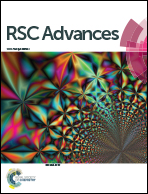Microbial lipid production from AFEX™ pretreated corn stover†
Abstract
Lipids having high carbon to heteroatom ratios can be upgraded to bio-diesel and jet fuels which are more advanced drop-in fuels compared to ethanol. The present study investigated microbial lipid production from Ammonia Fiber Expansion (AFEX) pretreated and hydrolyzed corn stover (CS) using an oleaginous yeast strain Lipomyces tetrasporus NRRL Y-11562. Process conditions were optimized for carbon to nitrogen ratio of fermentation medium, fermentation temperature and pH, and solid loading of AFEX–CS. The inhibitory effect of AFEX degradation products on lipid fermentation was also investigated. Both separate hydrolysis and fermentation (SHF) and Rapid Bioconversion with Integrated recycle Technology (RaBIT) processes were used for lipid production. From 1 kg AFEX–CS, 36.7 g lipids were produced via SHF at a titer of 8.4 g L−1 with a yield of 0.08 g g−1 consumed sugar. A yeast meal stream (97.9 g) was also generated. L. tetrasporus NRRL Y-11562 grew better in AFEX–CS hydrolysate, but produced fewer lipids compared to synthetic medium. Minimal washing of AFEX–CS improved the lipid yield and titer to 0.10 g g−1 consumed sugar and 10.7 g L−1, respectively. RaBIT on washed AFEX–CS generated a similar amount of lipids compared to SHF with 35% lower enzyme loading. Economic analysis does not favor lignocellulosic lipid production with current lipid yields.


 Please wait while we load your content...
Please wait while we load your content...